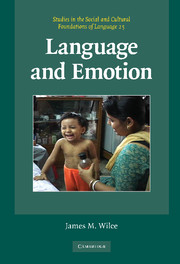Book contents
- Frontmatter
- Contents
- List of figures
- List of transcripts
- Acknowledgements
- Introduction
- Part I Theory
- Part II Language, power, and honor
- Part III Identification and identity
- Part IV Histories of language and emotion
- 9 A history of theories
- 10 Shifting forms of language and emotion
- 11 Language and the medicalization of emotion
- 12 Conclusion
- Notes
- Glossary
- References
- Index
- STUDIES IN THE SOCIAL AND CULTURAL FOUNDATIONS OF LANGUAGE
12 - Conclusion
Published online by Cambridge University Press: 05 June 2012
- Frontmatter
- Contents
- List of figures
- List of transcripts
- Acknowledgements
- Introduction
- Part I Theory
- Part II Language, power, and honor
- Part III Identification and identity
- Part IV Histories of language and emotion
- 9 A history of theories
- 10 Shifting forms of language and emotion
- 11 Language and the medicalization of emotion
- 12 Conclusion
- Notes
- Glossary
- References
- Index
- STUDIES IN THE SOCIAL AND CULTURAL FOUNDATIONS OF LANGUAGE
Summary
Having come this far, are we any clearer about what emotion is? Emotion's ontological status or precise denotation – its semantic intension – did not claim most of our attention. But I hope I have clarified emotion in its relation to language, by demonstrating the breadth of its semantic extension and the range of pragmatic effects that follow emotion talk.
Throughout previous chapters, I have described not only emotion talk, but reflections on it – be they everyday, philosophical, or anthropological – as forms of social action. We have explored the implications of this claim for how such action might be, in various forms, efficacious, performative, or powerful. No emotion-related discourse is more transformative than those metadiscourses that reframe emotion talk. Perhaps the central example of this is what Foucault (1990) calls the “incitement to discourse,” starting in a church-confessional context where sins of feeling and thought needed confessing, passing into a medicalizing context that solicits and pathologizes emotion-talk (the famous talking cure was just the beginning) or its absence (the category “alexithymia”), and thereby produces the modern, individuated self.
The previous paragraph, and the consistent invocation throughout it of emotion – a single lexeme indexing what, to us, appears as a transparent category with natural integrity – points to, but also masks, a history: Each generation, in every society, produces and uses its own taxonomy organizing various facets of subjectivity. This may involve one umbrella term – or several major, inclusive categories – as well as myriad labels for the entities envisioned as nodes included under those inclusive terms. Some of these resist simple equation in comparing different cultural systems.
- Type
- Chapter
- Information
- Language and Emotion , pp. 182 - 190Publisher: Cambridge University PressPrint publication year: 2009

